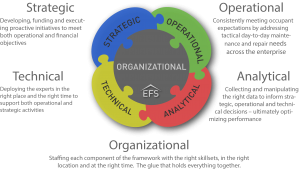In the 1999 cult comedy Office Space, the character Tom Smykowski (you know – the “jump to conclusions” mat guy) plays the role of a misunderstood office worker challenged with justifying the value of his role as a liaison between his company’s technical staff and its customers. “I deal with the (expletive) customers so the engineers don’t have to. I have people skills!”. Not a very good argument. One might think of the facilities executive as being in a similar role to Tom.
In my experience, this isn’t far from the truth. Although technical skills are usually valued in a non-technical organization with multiple facilities, they are often misunderstood and can be compartmentalized and pigeon-holed. Without an internal technical advocate or champion – more effective than Tom Smykowski, I might add – it isn’t long before executives begin to question the value of this important staffing element. This is especially true when a business is in cost-cutting mode. In the management of today’s increasingly complex multi-site facility portfolios, it is critical that any organization understand their technical needs and have a bench of experts to call upon when needed.

The objective of the technical element of the SAM framework is to ensure the right technical expertise is available and deployed in the right place and at the right time. Whether that expertise is in-house or outsourced to vendors or consultants, it is the facility executive’s responsibility to know when and where to engage the experts – and to advocate for, and sell, that need to internal decision makers.
Technical expertise will add significant value when called upon for the following not-all-inclusive list of tasks:
- Resolving systemic technical challenges at specific locations (or across the portfolio) when operational processes or skillsets fail
- Supporting under-performing vendors by providing an enhanced level of both training and accountability within a given market or region
- Identifying technical initiatives that reduce energy and maintenance costs
- System design, selection and commissioning in support of new construction, retrofits, upgrades or replacements
- Developing models to quantify and communicate the four components that make up the total cost of ownership of an engineered asset (all critical when contrasting multiple design or procurement strategies):
- Capital investment (equipment & installation)
- Energy
- Maintenance and repair
- Reliability
- Understanding and communicating how changing codes, standards and regulations will impact the current and future asset base – in both financial and operational terms
Without technical expertise, the facilities executive may be leaving money on the table – or worse yet, be blindsided by financial or operational surprises.
Here are a few tips for articulating the need for technical support:
- Quantify things – articulate the value of engineered assets in the portfolio. An installed HVAC asset base of 5,000 packaged rooftop units might be valued at $50M – and cost $10M in annual energy expense and $3M in annual repair costs – lots of opportunity for technical expertise to optimize that spend.
- Tell stories – find examples where technical resources either saved money (energy, capital) or prevented an operational hiccup. Perhaps an engineer diagnosed a systemic issue as a manufacturing defect that impacted 600 pieces of equipment in the portfolio – prompting a mass fix at the manufacturers expense that reduced operating costs and improved reliability. Tell the story in financial terms relative to the financial return on the cost of the engineer’s time.
- Find an advocate partner – Seek out senior leaders who understand the value and importance of technical expertise – engage them in helping you build support for the right resources.
Whatever your role within an organization that operates multiple facilities, take the time to understand your technical needs and ensure you have the right resources available – and if you don’t know how to find that answer, bring in an outsider to help! What are you doing to ensure you have the right technical resources at your disposal?
